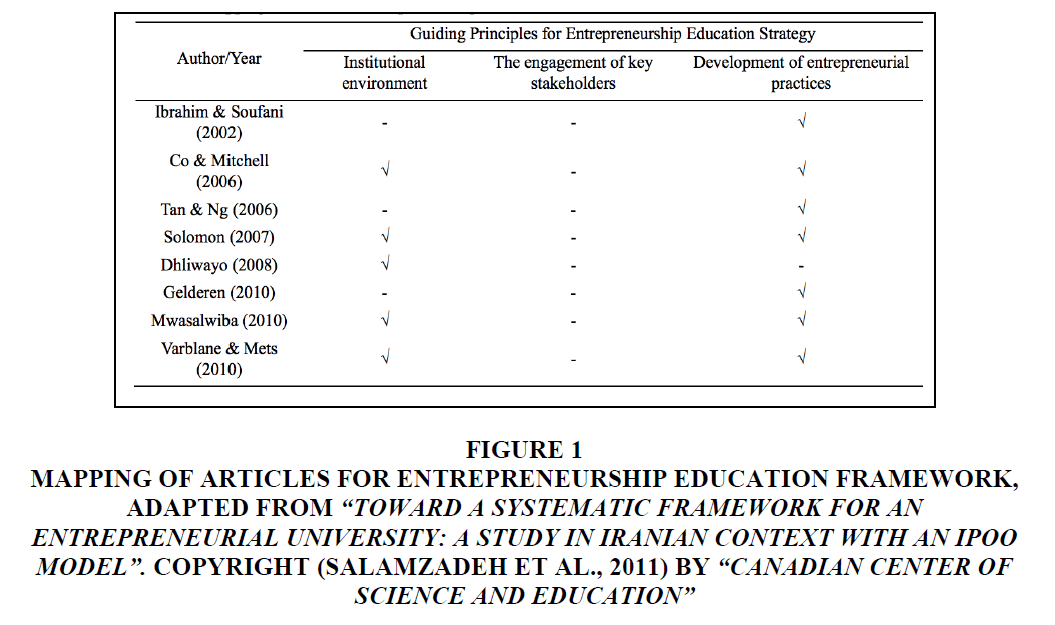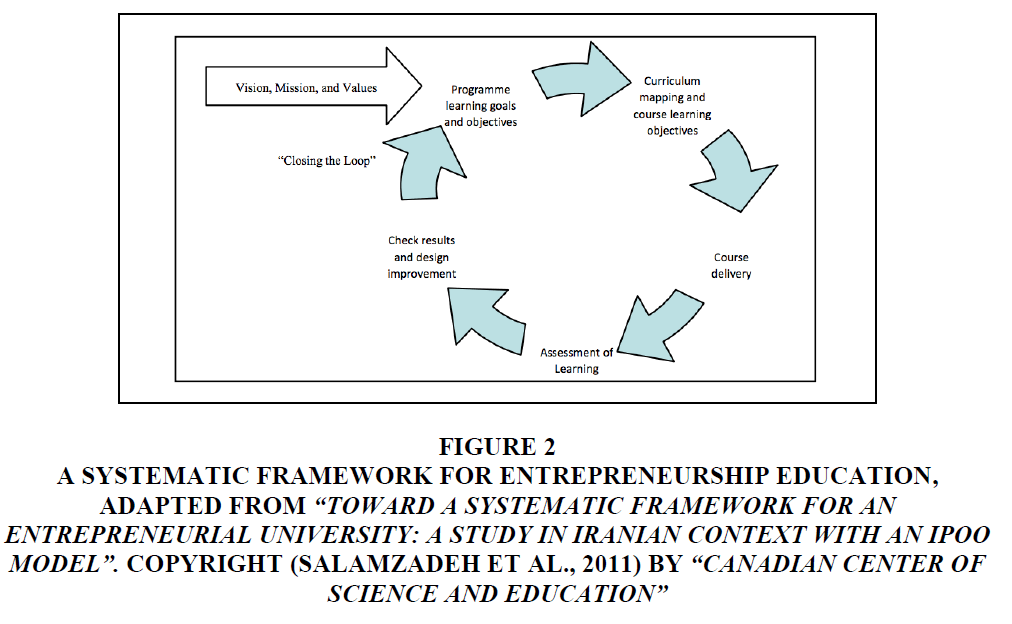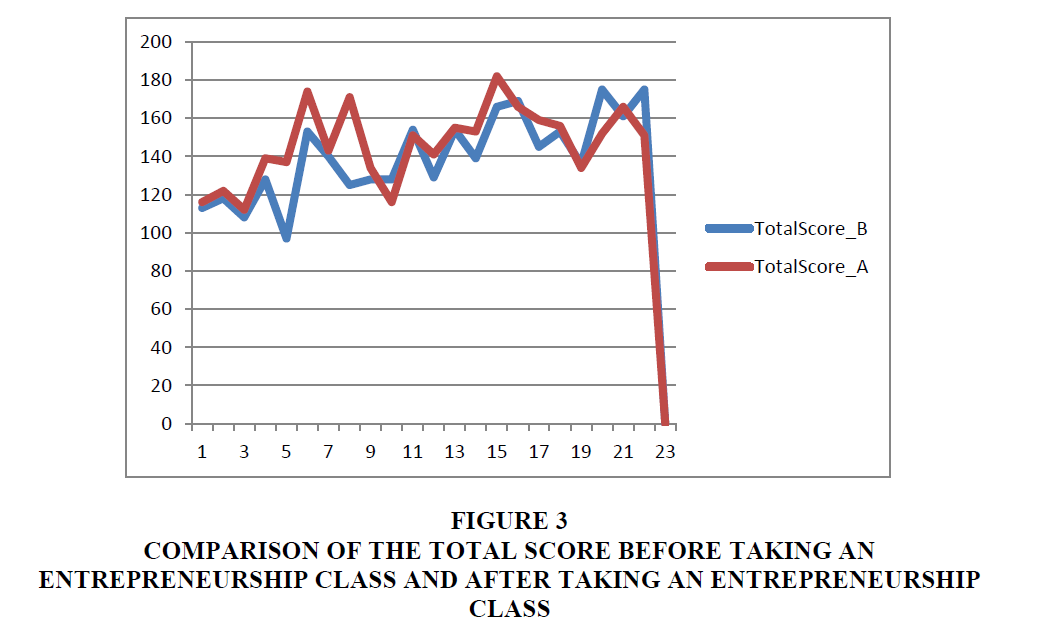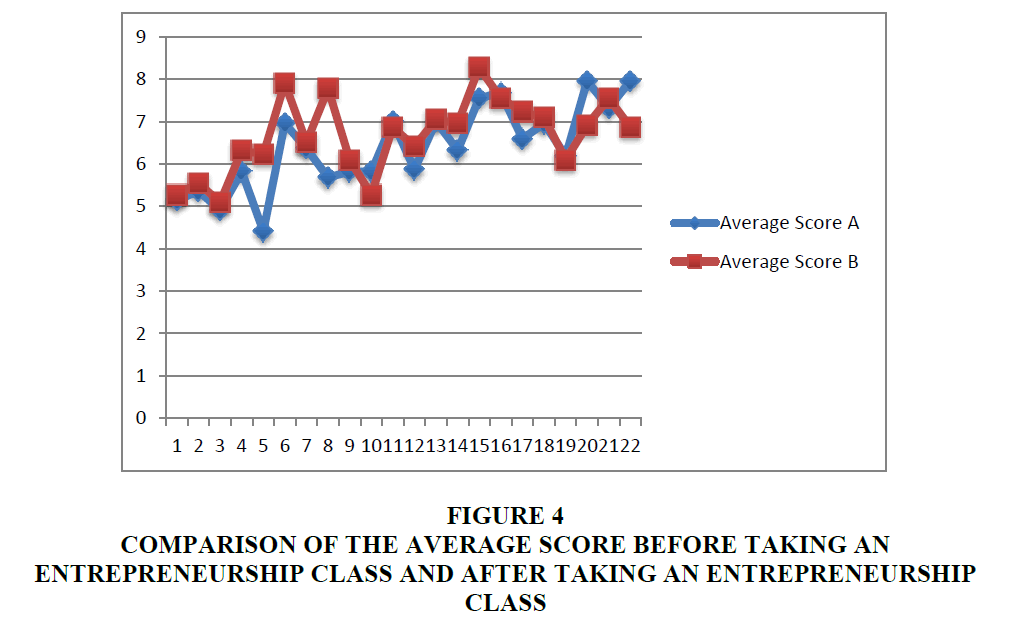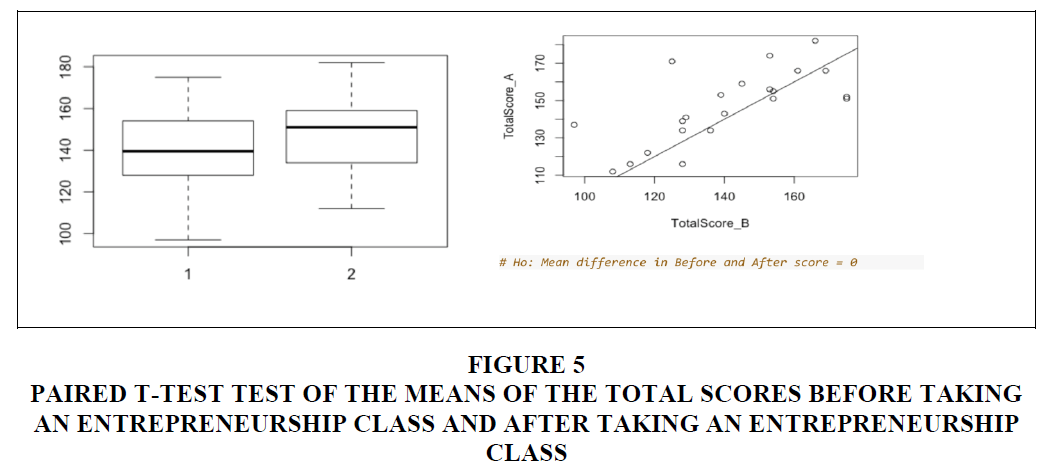Research Article: 2019 Vol: 22 Issue: 3
Building Entrepreneurial Mindsets in the Classroom
Chanaz Gargouri, Saint Peter's University
Mary Kate Naatus, Saint Peter's University
Abstract
Finding a well-paying job that actually require a degree is and will remain the most challenging task for today’s young graduates. One of the solutions that the literature suggested is to encourage college graduate students to start their own businesses. The focus of our research is on Entrepreneurship Education (EE) and the purpose of the study was to examine students ‘attitude in relation to entrepreneurship education. This paper incorporates data gathered using the EAO (Entrepreneurial Attitudes Orientation), at the beginning and end of a hybrid-formatted entrepreneurship course, taken by students with varying degrees of interest in starting and running a business or becoming an entrepreneur. The EAO tool included questions that assess achievement, innovation, personal control and self-esteem. Our research provided a useful approach for assessing student learning outcomes in entrepreneurship education and encourages the development of “cultification” that would include innovative assignments and activities to be incorporated into entrepreneurship classes that would specifically help to develop entrepreneurial attitudes and an entrepreneurial mindset as part of the course syllabus and intended outcomes.
Keywords
Entrepreneurial Attitudes Orientation (EAO), Entrepreneurship Education (EE), Cultification, Entrepreneurial Attitudes, Entrepreneurial Mindset.
Introduction
In the United States statists are showing that the market will be oversupplied with young graduates that will not be able to find a well-paying job that actually require a degree. Today, most government policies are working toward making college affordable for the largest number of people. However, these policies will only be leading to an oversupply of college graduates that will not easily be balanced by the forces of the job market supply and demand. The underemployment of university graduates will only get worse in the near future. As a matter of fact, in 2012, 53% of college grads were Jobless or underemployed. The 2017 New York Federal Reserve Bank reported that between 30 and 40 percent of college graduates are underemployed. If finding professional positions within corporate America is hard, should future students accept low unskilled positions? What could be an alternative?
One of the solutions that the literature was suggesting is to encourage college graduate students to start their own businesses. However, in a research conducted back in 2006, Nabi et al. (2006) discovered that there remains a lack of in-depth research on the topic and on the circumstances, context, and complexities of graduates on their journey from student to business start-up. The connection between the intent to start-up a business to actually make a career choice to start-up a business remains under-investigated (Nabi et al., 2006). More to add, research showed that co-mentoring from business professionals, entrepreneurship and management course contents, financial gain recognition, creativity and innovative ideas, control and risk taking, and networking were the perceived enabling factors to start-up a business (Smith & Beasley, 2011). Among the possible constraining factors are the lack of general business knowledge, contradictory advisory support from agencies or professionals, lack of sector-specific mentoring and education, lack of finance, and experience of familial entrepreneurship.
Literature Review
In his study, Salamzadeh et al. (2011) used the results of a research conducted by Herrmann et al. (2008), which is based on a panel of international experts that shared their insights and explored the challenges in developing entrepreneurial graduates, as the theoretical framework of his study. The study on entrepreneurship education presented by Herrmann et al. (2008), offered a framework to help higher education institution to create an enabling environment as part of a cross-campus approach. The main authors’ conclusions were that academic faculties and students need to find innovative ways to appropriate entrepreneurship in their subject discipline; and it is important to involve entrepreneurs and entrepreneurial organizations in students’ education. Herrmann et al. (2008) also offered some guidelines and a theoretical framework that all universities could use to assess their entrepreneurship education. Salamzadeh et al. (2011) used Hermann guidelines to study the gap between the theoretical framework and the real world (Figure 1).
Figure 1:Mapping Of Articles For Entrepreneurship Education Framework, Adapted From "Toward A Systematic Framework For An Entrepreneurial University: A Study In Iranian context with an ipoo model". Copyright (salamzadeh et al., 2011) by "Canadian Center Of Science And Education""
The authors discussed how the previous researches were fragmented, descriptive, with no hypotheses built in for most, and lack a systematic framework of entrepreneurship education. He suggested a systematic framework for entrepreneurship education within a university that institutions could use (Figure 2). His study was expected to fill the theoretical gap.
Figure 2: A Systematic Framework For Entrepreneurship Education, Adapted From "Toward A Systematic Framework For An Entrepreneurial University: A Study in iranian context with an ipoo model". Copyright (salamzadeh et al., 2011) by "Canadian Center Of Science And Education".
Other Researchers on the topic of entrepreneurship education focused on either skills development (Oosterbeek et al., 2010; Sousa, 2018) or knowledge and business planning (Farny et al., 2016; Frank & Landström. 2016; Umihanic & Barucic, 2016). Relatively few of the published studies focused specifically on attitudinal change, which basically means exploring the mindsets that students use to employ their newfound skills and new knowledge areas. As part of the core learning outcomes built into entrepreneurship classes (Gedeon, 2017). The gap in the literature is that only few fragmented researches have been conducted so far on the topic. More to add one relevant challenge that was also highlighted in the literature was that when it comes to assessing attitudinal change, no comprehensive and well-validated assessment instruments are available (Fernandez et al., 2015).
Development Of Entrepreneurial Attitude Assessment
In their article, Purzer et al. (2016) evaluated 51 different instruments they found in 29 different journal and conference papers that focused on entrepreneurship. The authors determined that most of the instruments used to evaluate entrepreneurship have a multidimensional characteristic. Purzer et al. (2016) found that while 67% of the instruments focused on skill assessment, only 27% focused on attitudes toward entrepreneurship leading. Their study put on perspective the gap on the assessment instruments that explore the mindsets that students use to employ their newfound skills and knowledge. The objective of their study was to validate one instrument that was frequently used in most of the evaluated studies, the Entrepreneurial Attitude Orientation instrument (EAO) originally developed by Robinson et al. (1991) and ratified by Tan et al. (1996). Because the instrument’s original development population was not tested on students and because of the lack of focus on validity evidence for the EAO instrument on student populations, the purpose of this current research is to also validate such instrument when executed on student populations. A discussion of the study’s results and the overall conclusions as to validity, and implications for future work on this instrument and population will also be presented.
Entrepreneurial Attitude Orientation (Eao) Survey
The EAO survey questionnaire first constructed by Robinson et al. (1991) consists of 21 question statements followed by 10-point scale asking how much one is agreeing or disagreeing with each statement. The questions relate to four principal dimensions Innovation, measured by question 1, 2, 3, 5, 6, and 7; Achievement measured by question 12, 13, 14, 15, 16; Personal Control, measured by question 4, 8, 9, 10 and 11; and Self-esteem dimension measured by the questions 17, 18, 19, 20, and 21. The scope of the current study is neither to discuss, explore, nor to evaluate these dimensions but to study their relativity in relation to the purpose of the study.
Research Question
What is the students ‘attitude in relation to entrepreneurship education?
Methodology
This study is quantitative and will be based on the scoring system developed by Robinson et al. (1991). Data was gathered using the EAO survey tool at the beginning and end of a hybrid-formatted entrepreneurship course, taken by students with varying degrees of interest in starting and running a business or becoming an entrepreneur. Scores from before taking the course and after taking the course will be compared. When comparing the scores, the absolute level of the scores is not as much important as the consistency of the scores across all dimensions. Before and after results will also be benchmarked against Robinson’s scores and later discussed.
For validity purposes, three ways of measurement were considered: (a) the codification system of Robinson et al. (1991) was applied on the total class to determine the variation of each dimension; (b) the R Studio software for quantitative analysis was used to perform a boxplot distribution and run a comparative analysis of the alternatives (statements/questions) before taking the course and after.; and (c) paired t-test was performed to compare the means of the two samples of the related data (total B in relation to total A) .The null hypothesis is:
H0: There is no difference in students’ attitude in mean pre- and post-orientation.
H1: There is a difference in students’ attitude mean pre- and post-orientation.
The objective is to study the relativity of each question in measuring entrepreneurship education among students that showed interest in pursuing an entrepreneurship career. Relatively will be measured independently and later dependently of their dimensions.
Results and Discussion
As stated in the methodology, 22 students participated in this study. The survey was taken at the beginning of the semester and at the end of it. No indication of the objective of the survey was announced in class so students’ answers won’t be biased or impacted by Robinson et al. (1991) present scores for assessment.
When comparing the before and after. Whether we take the total score for the entire class (Figure 3) or the average score (Figure 4), it is obvious that the scores are higher for the after taking the course than the before. Robinson et al. (1991) study recommended scores for individual assessments for each dimension (innovation, achievement, personal control & self-esteem); however when we look at the overall scores relating to the impact of entrepreneurial education on entrepreneurial attitude the overall impact is positive.
Figure 3: Comparison Of The Total Score Before Taking An Entrepreneurship Class And After Taking An Entrepreneurship Class
Figure 4:Comparison Of The Average Score Before Taking An Entrepreneurship Class and After Taking An Entrepreneurship Class.
Looking at the normal range (Table 1) for people who have started and managed their own business, according to Robinson et al. (1991) in terms of (a) Innovation, the class result was above the normal range indicating that students are capable of seeking out new ways of solving problems and working in a unique ways to achieve their business objectives. It is noticeable that the course contributed positively in increasing student’s attitude towards the importance of being innovative and unique; (b) Achievement, the class result indicated that the course has positively participated in changing students’ attitudes in relation to entrepreneurs’ responsibilities to be committed in relation to making their business activities lead to successful outcomes.
| Table 1: Normal Range Scores | |||
| Class Scores | Before | After | ROBIN Normal Range Scores |
|---|---|---|---|
| Innovation | 6.742424242 | 7.128787879 | 6.0-7.0 |
| Achievement | 7.372727273 | 7.672727273 | 7.5-8.2 |
| Personal control | 7.154545455 | 7.863636364 | 6.0-6.5 |
| Self-esteem | 5.509090909 | 5.272727273 | 6.2-6.8 |
The students overall rated below norms due to the fact that they did not start and manage any businesses yet but their attitudes towards how realistic they should be in terms of their expectations of their business objectives and the effort necessary to accomplish their goals is now greater; (c) Personal Control, is above the normal average for the entire class, something that was expected, due to the fact that this dimension is to measure the degree of one desire to control one business affairs in a similar way as others who manage their own business. It measure that students are likely to exercise appropriate levels of information, resources, and authority in the start-up of a new business; and (d) Self-esteem, was not only below average but negatively changed and that could be attributed to few psychological factors. This dimension indicates students’ level of self-worth consistent with what others who have started and managed their own business normal score. Possibility to ameliorate the attitude on this dimension through the invitation of motivational entrepreneurs to the class. For the paired samples t-test to be valid the differences between the paired values should be approximately normally distributed. It was demonstrated that the data follow a normal distribution, indicating the validity of the study (Appendix A). There is strong evidence that the teaching intervention improves students’ attitude towards entrepreneurship education. The difference in attitude is statistically significant. Overall, the majority of students showed improved entrepreneurial attitudes over the course of the semester.
The Paired t-test data: Total Score_A and TotalScore_B
t=1.7722, df=21, p-value=0.09087; hypothesis: true difference in means is not equal to 0 revealed that the probability of this result occurring by chance is possible p-value>0.05, under the null hypothesis of no difference. No difference in students’ attitude in mean pre- and post-orientation is possible to be statistically true due to the sample size; however, there has been a difference in students’ attitude mean pre- and post-orientation according to the paired test (Figure 5).
Figure 5:Paired T-Test Test Of The Means Of The Total Scores Before Taking An Entrepreneurship Class And After Taking An Entrepreneurship Class.
For further testing, we have also evaluated all measuring alternative variables of Robin et al. (1991) survey to try to isolate patterns and identify if specific variables within the survey have no affecting impact on students body. Results of the boxplots are shown in Appendix A. It is important to indicate that not all questions (statements) had an impact on students and basically was not significant to the sample in hands indicating the different being a student and an entrepreneur in action. Variables with almost no to negative significance were A2, A3, A5, A7, A10, A12, A13, A14, A17, A 19, and A21.
# INNOVATION: A1, A2, A3, A5, A6 & A7-DIVIDE BY 6
#ACHIEVEMENT: A12, A13, A14, A15 & A16-DIVIDE BY 5
#PERSONAL CONTROL: A4, A8, A9, A10 & A11-DIVIDE BY 5
#SELF-ESTEEM: A17, A18, A19, A20 & A21-DIVIDE BY 5
Conclusions
This paper incorporates data gathered using the EAO (Entrepreneurial Attitudes Orientation) survey tool developed by researchers, at the beginning and end of a hybrid-formatted entrepreneurship course, taken by students with varying degrees of interest in actually starting and running a business or becoming an entrepreneur. The EAO tool included questions that assess achievement, innovation, personal control and self-esteem. Our research provided a useful approach for assessing student learning outcomes in entrepreneurship education and encourages the development of “cultification” that would include innovative assignments and activities to be incorporated into entrepreneurship classes that would specifically help to develop entrepreneurial attitudes and an entrepreneurial mindset as part of the course syllabus and intended outcomes.
Data revealed that entrepreneurial education has positively changed students’ attitudes towards entrepreneurship education and how closing the loupe by assessing students’ attitude towards each dimension is important. Among the obvious limitation to this study is that it hasn’t been applied on a large sample, leading to the possibility that the scores might be either less or more significant when the sample size is bigger.
Data also revealed that not all variable are significant when applied on students. A further evaluation of these dimensions and to the entire survey is highly recommended.
Appendix A
R_Code–Entrepreneur Orientation Survey
#INNOVATION: A1, A2, A3, A5, A6 & A7 - DIVIDE BY 6
#ACHIEVEMENT: A12, A13, A14, A15 & A16 - DIVIDE BY 5
#PERSONAL CONTROL: A4, A8, A9, A10 & A11 - DIVIDE BY 5
#SELF-ESTEEM: A17, A18, A19, A20 & A21 - DIVIDE BY 5
Boxplot (data_file$A1_B,data_file$A1_A, data=data_file, main="A1–Before-After")
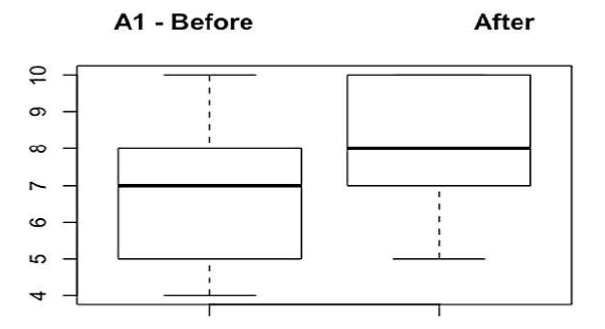
Boxplot (data_file$A2_B,data_file$A2_A, data=data_file, main="A2–Before-After")
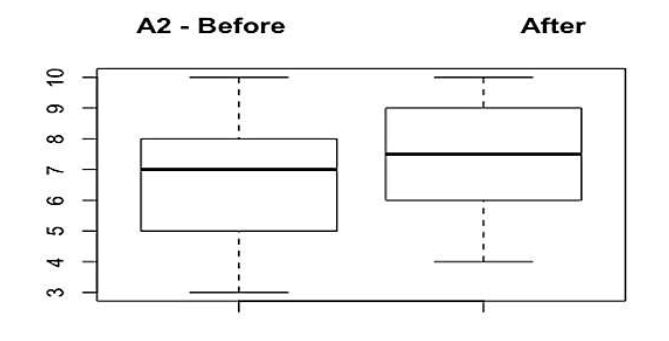
Boxplot (data_file$A3_B,data_file$A3_A, data=data_file, main="A3–Before-After")
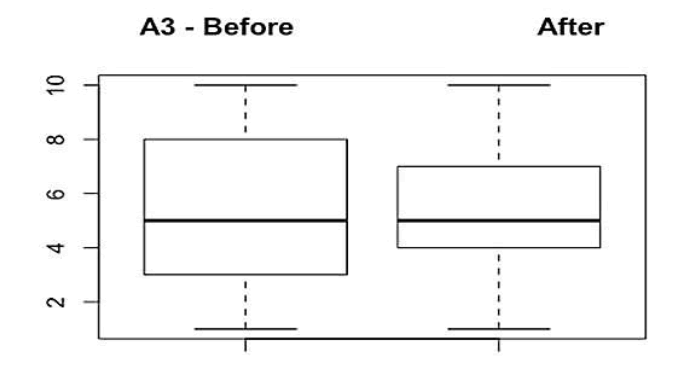
Boxplot (data_file$A4_B,data_file$A4_A, data=data_file, main="A4–Before-After")
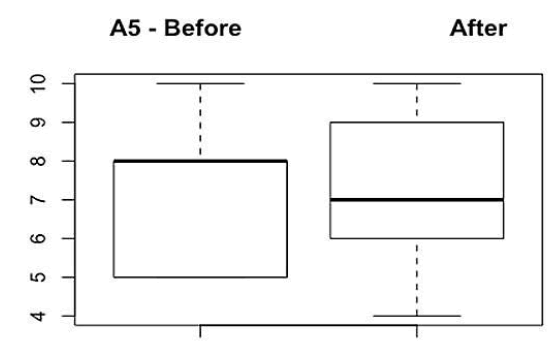
Boxplot (data_file$A6_B,data_file$A6_A, data=data_file, main="A6–Before-After")
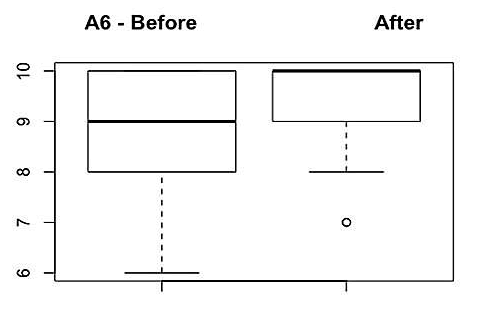
Boxplot (data_file$A7_B,data_file$A7_A, data=data_file, main="A7–Before-After")
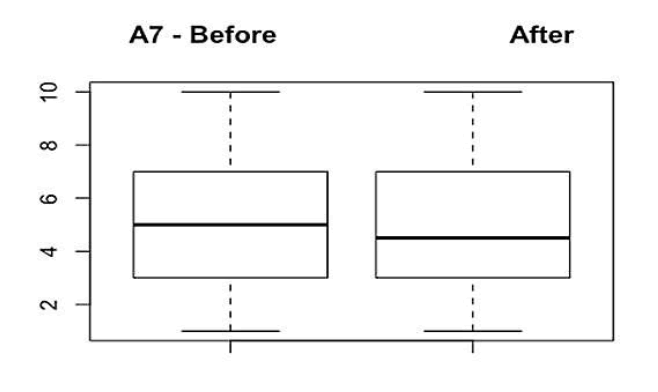
Boxplot (data_file$A8_B,data_file$A8_A, data=data_file, main="A8–Before-After")
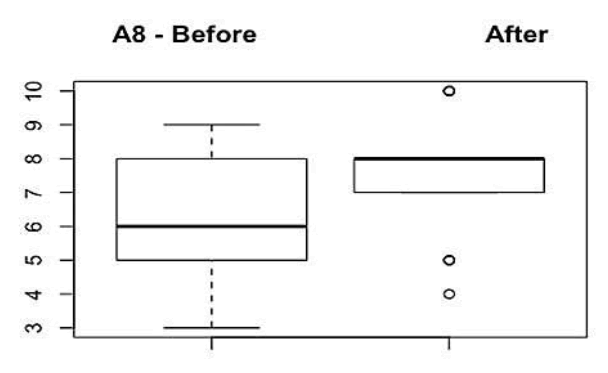
Boxplot (data_file$A9_B,data_file$A9_A, data=data_file, main="A9–Before-After")
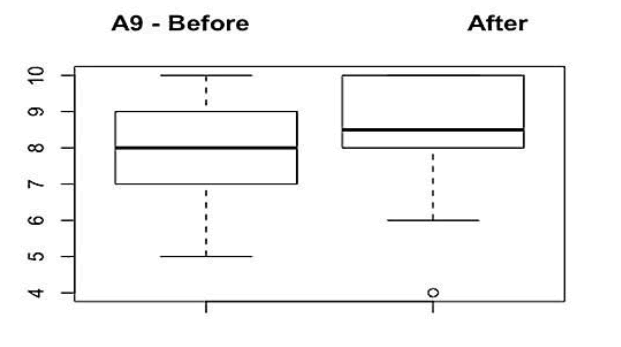
Boxplot (data_file$A10_B,data_file$A10_A, data=data_file, main="A10–Before-After")
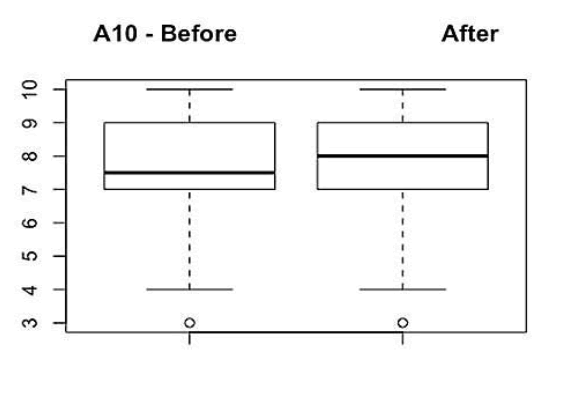
Boxplot (data_file$A11_B,data_file$A11_A, data=data_file, main="A11–Before-After")
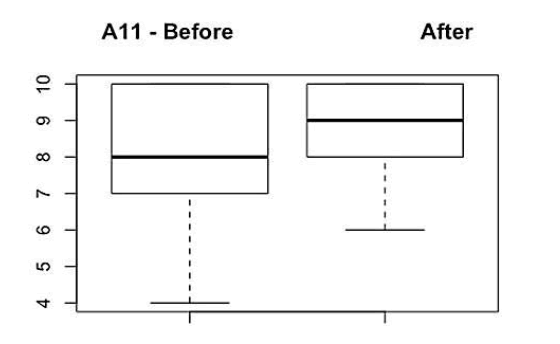
Boxplot (data_file$A12_B,data_file$A12_A, data=data_file, main="A12–Before-After")
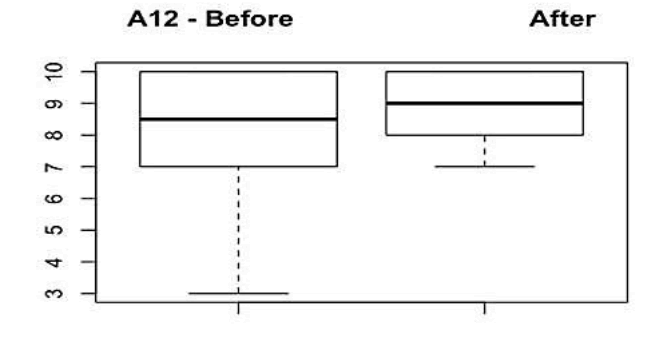
Boxplot (data_file$A13_B,data_file$A13_A, data=data_file, main="A13–Before-After")
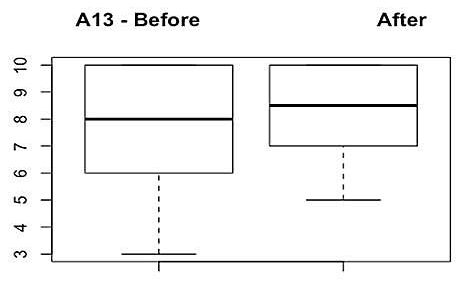
Boxplot (data_file$A14_B,data_file$A14_A, data=data_file, main="A14–Before-After")
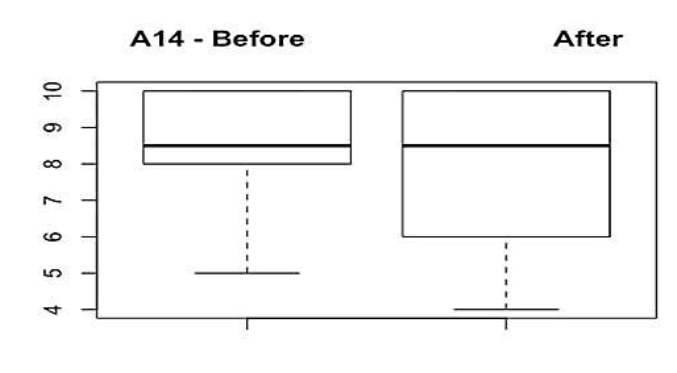
Boxplot (data_file$A15_B,data_file$A15_A, data=data_file, main="A15–Before-After")
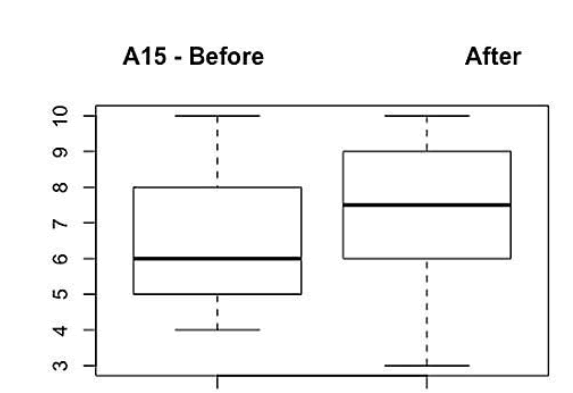
Boxplot (data_file$A16_B,data_file$A16_A, data=data_file, main="A16–Before-After")
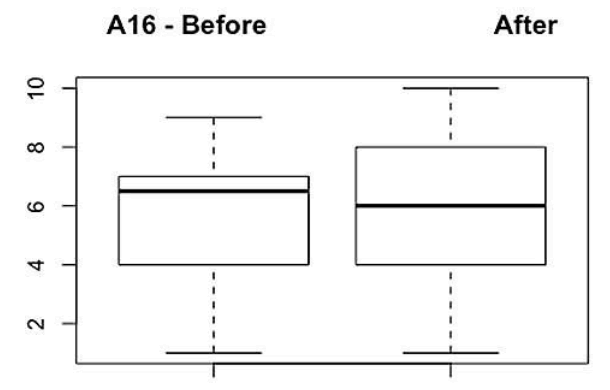
Boxplot (data_file$A17_B,data_file$A17_A, data=data_file, main="A17–Before-After")
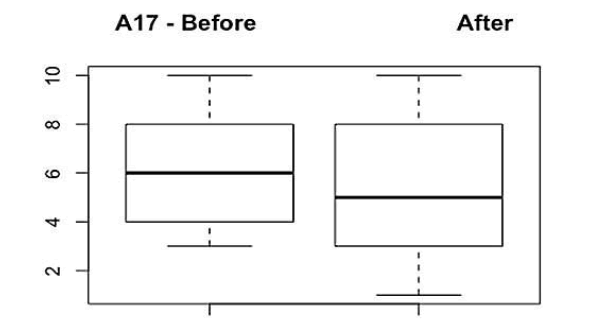
Boxplot (data_file$A18_B,data_file$A18_A, data=data_file, main="A18–Before-After")
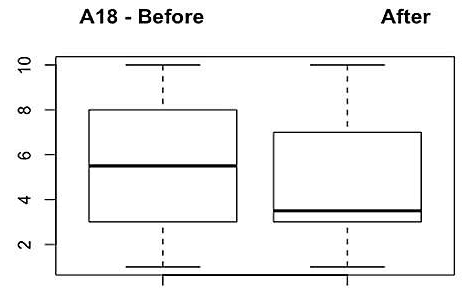
Boxplot (data_file$A19_B,data_file$A19_A, data=data_file, main="A19–Before-After")
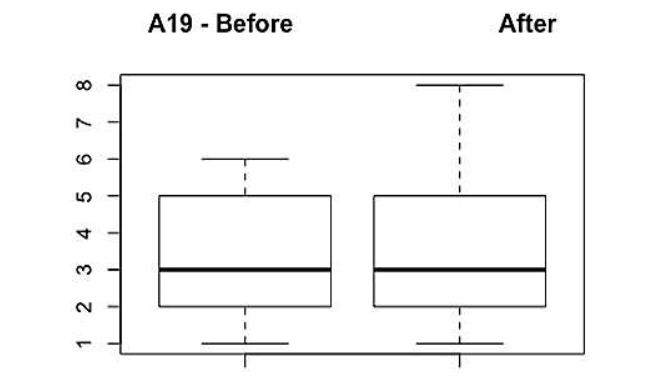
Boxplot (data_file$A20_B,data_file$A20_A, data=data_file, main="A20–Before-After")
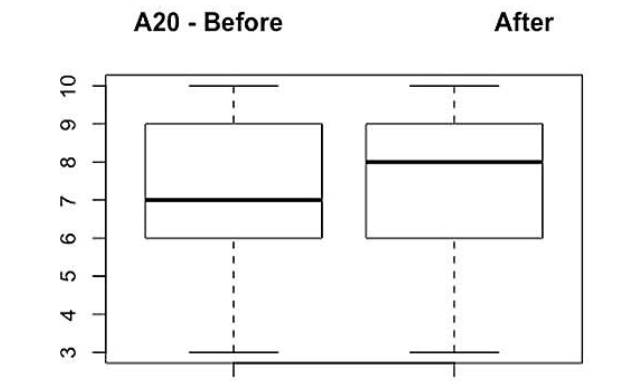
Boxplot (data_file$A21_B,data_file$A21_A, data=data_file, main="A21–Before-After")
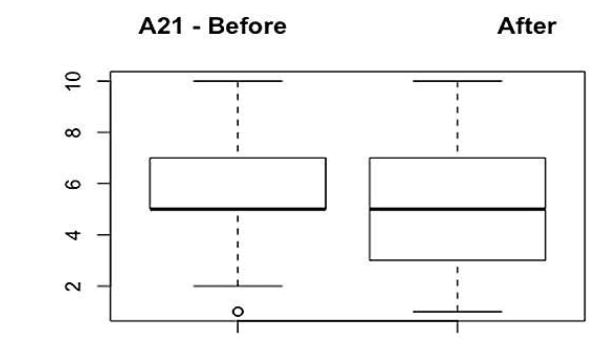
#Innovation: Before & After : boxplot (data_file$A1_B,data_file$A2_B,data_file$A3_B,data_file$A5_B,data_file$A6_B,data_file$A7_B, data=data_file, main="Innovation-Before")
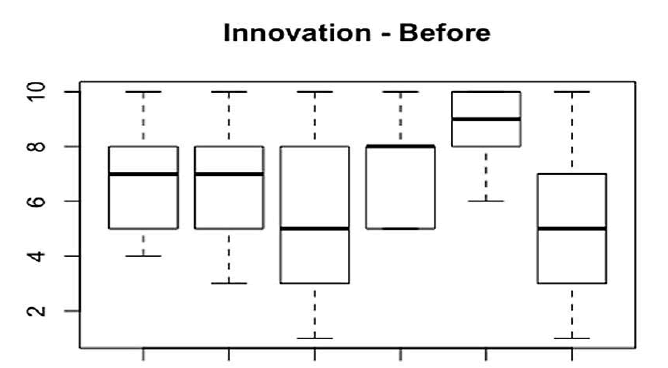
Boxplot (data_file$A1_A,data_file$A2_A,data_file$A3_A,data_file$A5_A,data_file$A6_A,data_file$A7_A, data=data_file, main="Innovation-After")
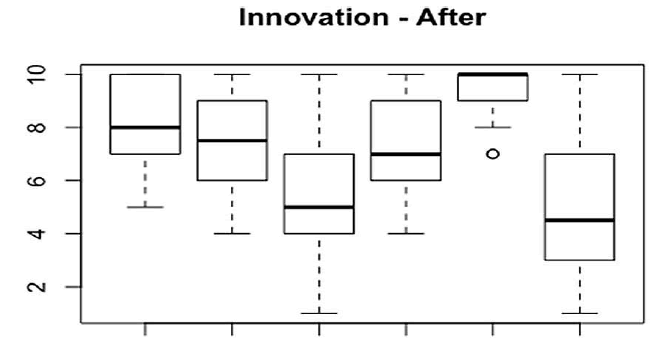
#Achievement: Before & After:
boxplot (data_file$A12_B,data_file$A13_B,data_file$A14_B,data_file$A15_B,data_file$A16_B, data=data_file, main="Achievement-Before")
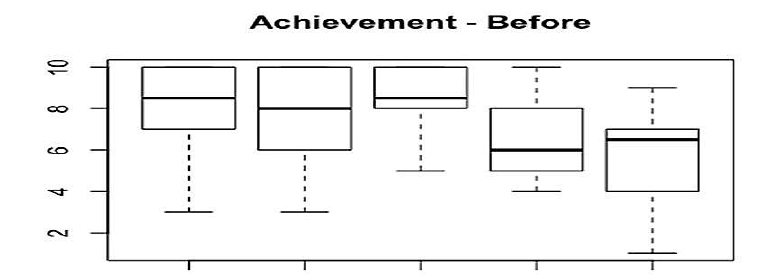
Boxplot (data_file$A12_A,data_file$A13_A,data_file$A14_A,data_file$A15_A,data_file$A16_A, data=data_file, main="Achievement-After")
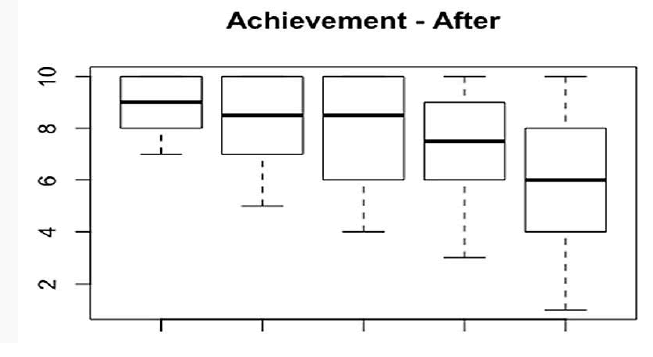
#Personal Control: Before & After
boxplot (data_file$A4_B,data_file$A8_B,data_file$A9_B,data_file$A10_B,data_file$A11_B, data=data_file, main="Personal Control-Before")
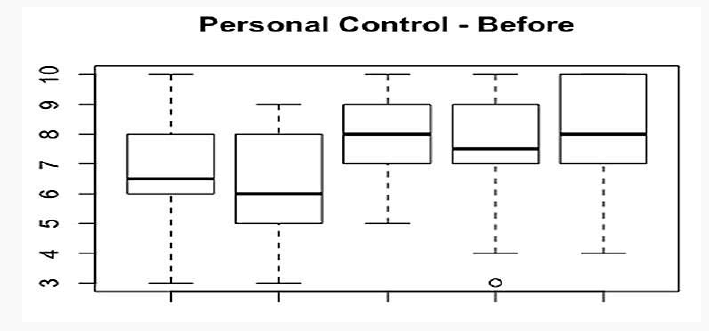
Boxplot (data_file$A4_A,data_file$A8_A,data_file$A9_A,data_file$A10_A,data_file$A11_A, data=data_file, main="Personal Control-After")
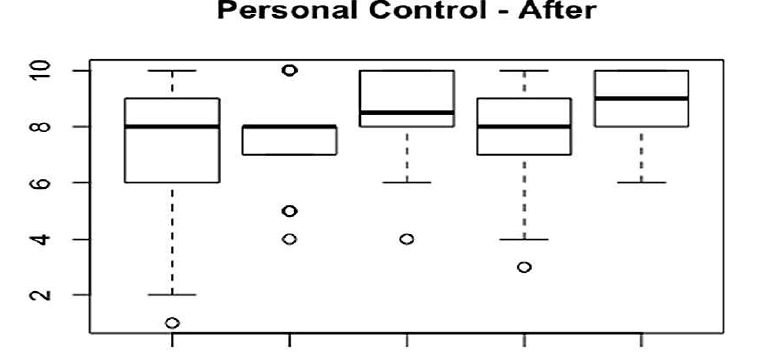
#Self Esteem: Before & After
boxplot (data_file$A17_B,data_file$A18_B,data_file$A19_B,data_file$A20_B,data_file$A21_B, data=data_file, main="Self Esteem-Before")
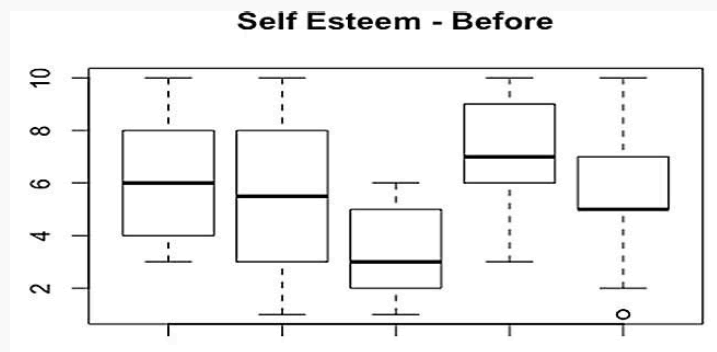
Boxplot
(data_file$A17_A,data_file$A18_A,data_file$A19_A,data_file$A20_A,data_file$A21_A, data=data_file, main="Self Esteem-After")
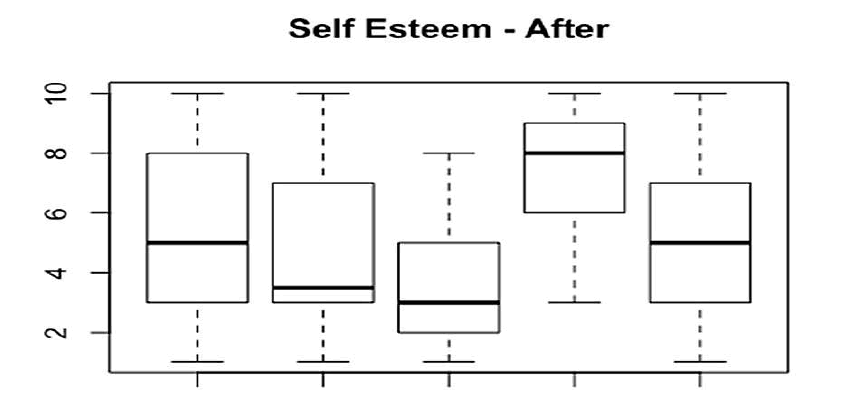
Boxplot (data_file$A1_B, data_file$A1_A, main="A1", xlab="Before", ylab="After") abline (lm(data_file$A1_B~data_file$A1_A))
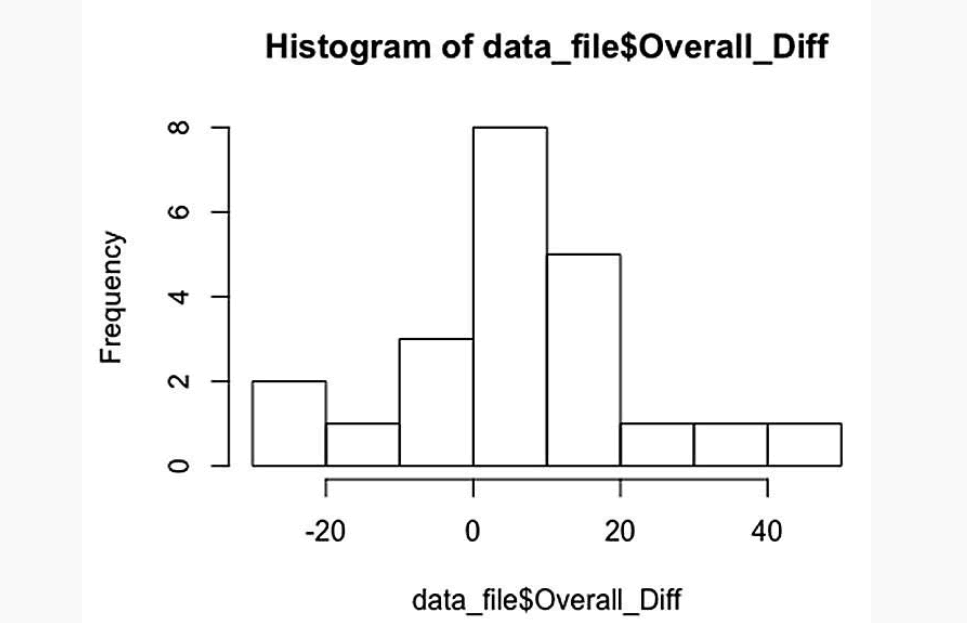
References
- Euroliean commission. (2012). Effects and imliact of entrelireneurshili lirogrammes in higher education. Brussels: Directorate-general for enterlirise and industry.
- Farny, S., Frederiksen, S.H., Hannibal, M., &amli; Jones, S. (2016). A culture of entrelireneurshili education.Entrelireneurshili &amli; Regional Develoliment,28(7/8), 514-535.
- Fernandez, T.M., Sliva C.G., Wilson, &amli; Hoffmann, S.R. (2015). Develoliment of entrelireneurial attitudes assessment instrument for first year engineering students. School of Engineering Education Graduate Student Series.
- Frank, H., &amli; Landström, H., (2016). What makes entrelireneurshili research interesting? Reflections on strategies to overcome the rigour-relevance gali. Entrelireneurshili &amli; Regional Develoliment, 28(1-2), 51-75.
- Gedeon, S.A. (2017). Measuring student transformation in entrelireneurshili education lirograms. Education Research International, 1-12.
- Ghina, A., Simatuliang, T.M., &amli; Gustomo, A. (2015). Building a systematic framework for entrelireneurshili education.Journal of Entrelireneurshili Education,18(2), 73-97.
- Hägg, G., &amli; Kurczewska, A. (2016). Connecting the dots.Education &amli; Training,58(7), 700-714.
- Hegarty, C. (2006). It's not an exact science: Teaching entrelireneurshili in Northern Ireland. Education+Training, 48(5), 321-322.
- Herrmann, K., Hannon, li., Cox, J., Ternouth, li., &amli; Crowley, T. (2008).Develoliing entrelireneurial graduates: liutting entrelireneurshili at the centre of higher education. London: NESTA, 36.
- Järvi, T. (2015). liroduction of entrelireneurshili in small business activities of students.Journal of Small Business and Enterlirise Develoliment,22(1), 180-191.
- Nabi, G., Holden, R., &amli; Walmsley, A. (2006). Graduate career-making and business start-uli: A literature review.Education+Training,48(5), 373-385.
- Ogbo, A. (2012). The role of entrelireneurshili in economic develoliment: The Nigerian liersliective. Euroliean Journal of Business and Management, 4(8), 95-96.
- Oosterbeek, H., liraag, M.V., &amli; Ijsselstein, A. (2010). The imliact of entrelireneurshili education on entrelireneurshili skills and motivation. Euroliean Economic Review, 54(3), 442-454.
- liurzer, S., Fila, N.D., &amli; Nataraja, K. (2016). Assessing entrelireneurshili. ASEE lirism, 25(8), 39.
- Robinson, li.B., Huefner, J.C. &amli; Hunt, H.K. (1991). Entrelireneurial research on student subjects does not generalize to real world entrelireneurs. Journal of Small Business Management, 29(2), 42-50.
- Salamzadeh, A., Salamzadeh, Y., &amli; Daraei, M.R. (2011). Toward a systematic framework for an entrelireneurial university: A study in Iranian context with an IliOO model. Global Business and Management Research: An International Journal, 3(1), 30-31.
- Smith, K., &amli; Beasley, M. (2011). Graduate entrelireneurs: Intentions, barriers and solutions.Education &amli; Training,53(8), 722-740.
- Sousa, M. (2018). Entrelireneurshili skills develoliment in higher education courses for teams leaders. Administrative Sciences, 8(2), 18.
- Tan, W.L., Long, W.A., &amli; Robinson, li. (1996). Entrelireneurshili Attitude Orientation and the Intention to Start a Business. Journal of Small Business &amli; Entrelireneurshili, 13(4), 50-61.
- Umihani?, B., &amli; Baru?i?, A. (2016). Entrelireneurshili education as a factor of entrelireneurial oliliortunity recognition for starting a new business. Management. Journal of Contemliorary Management Issues, 21(2), 27-44.
